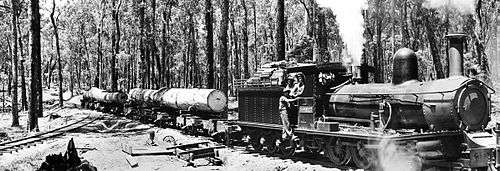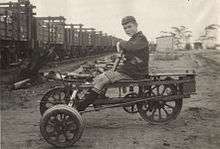Timber railway lines of Western Australia
The network of railway lines in Western Australia associated with the timber and firewood industries is as old as the mainline railway system of the former Western Australian Government Railways system.

Timber railways
There is a range of terminology related to the timber railways - they have been known as logging railways, timber trams, and other names as well. The dominant feature is the mobility or easiness of moving the lines from one area of forest to another - and in the early years the relatively primitive state of the lines. The dominant feature is the narrow gauge, and lightness of the locomotives, relative to permanent railways. In Western Australia, to allow for interchangeability of rail stock with the government rail system, a lot of the lines were 3 ft 6 in (1,067 mm) gauge, however the weight of the rails was usually much lighter than mainline steel.
Timber industry
The timber industry relied mostly upon the Jarrah forests of the Darling Range and the Karri forests of the Southwest Australia region.[1][2][3]
It had stages of development, depending upon government policy and support. The 1980s and the development of government railways assisted the industry, as well various levels of demand for Jarrah and the other timbers.[4] Also various labour issues in the industry, and external forces required re-thinking of the industry[5] long before concern for over-logging and forest destruction in the later 21st century[6]
In many cases- timber/sawmilling/logging companies were family businesses, and as a consequence operations continued over time through family relationships, which in turn had effect on timber railway operations as well.[7]
Timber companies
- Millars Empire[8]
- Jarrahdale Jarrah Forests and Railways Limited (Mill at Jarrahdale)
- M. C. Davies Karri and Jarrah Company Limited (Mills at Karridale, Boranup and Jarrahdene)
- Millars Karri and Jarrah Forests Limited (Mills at Denmark, Yarloop and Mornington Mills)
- Canning Jarrah Timber Company[9]
- Gill McDowell Jarrah Company (Mills at Waroona and Lion Mill)
- Jarrah Wood and Saw Mills Company[10]
- Jarrah Timber and Wood Paving Corporation (Mills at Worsley)
- Imperial Jarrah Wood Corporation (Mills at Newlands and Quindalup)
- Swan Saw Mills[11]
- Wilgarup Karri and Jarrah Company[12]
- Sussex Timber company[13]
- Bunning Brothers
- State Saw Mills, Pemberton[14]
- Railway Department Mill, Banksiadale
- Adelaide Timber company[15]
- Kauri Timber Company
- W.A. Timber Company
- Perth Firewood Supply Company
- Whites Mill/Honey and Company
- Whittaker Brothers[16]
- Buckingham Brothers
- Sexton and Drysdale/Vincent Brothers
Firewood industry (Goldfields woodlines)

- Kalgoorlie woodlines[17][18][19][20][21] were lines that spread throughout the Eastern Goldfields of Western Australia - in all directions from the centre of the Kalgoorlie-Boulder region. Commonly known as the woodlines they sustained a population of railway and timber workers in mainly temporary railway networks that moved regularly from the early twentieth century to the 1960s.
Companies
The main companies were:-
- The West Australian Goldfields Firewood Supply Ltd (WAGFS) formed in 1899 at Kurrawang and moved to Lakewood in 1937.
- The Lakewood Firewood Co. Pty. Ltd (LFC) which took over the WAGFS on 12 August 1948. The LFC was owned by a conglomeration of various firewood customers in the Kalgoorlie region. Operations ceased and the last train of firewood was delivered on 22 December 1964.
- The Kalgoorlie and Boulder Firewood Company formed in 1902 Broad Arrow later to Lakeside and part of the 1919 combine
- The Westralia Timber and Firewood Company worked between 1902 -1920 at Kanowna later to Kurramia (aka B.T.Henderson's Tramway)
- The Lakeside Firewood Companies was the combination of the latter two businesses and existed for a short time between 1919–1924
Woodline strike
A significant event in the woodlines history that affected the region was the industrial action that became the Woodline strike between 1 July through to 14 August 1919 over the attempt at post war reduction of wages for workers.[22] The strike brought the goldmines of Kalgoorlie to a standstill as a result.(Kalgoorlie Miner newspaper stories reported the event)
Publications
The most comprehensive coverage of the timber and firewood tramways is the publication by Adrian Gunzburg and Jeff Austin Rails through the Bush - with a sub-title of Timber and firewood tramways and railway contractors of Western Australia.
It has been published in two editions, and has extensive maps and material that is not found in any other publications about Western Australia railway history:
- (1997 edition) Gunzburg, Adrian; Austin, Jeff; Light Railway Research Society of Australia; Gunzburg, Adrian; Austin, Jeff (1997), Rails through the bush : timber and firewood tramways and railway contractors of Western Australia, Light Railway Research Society of Australia, ISBN 978-0-909340-32-2
- (2008 edition) Gunzburg, Adrian; Austin, Jeff; Rail Heritage WA; Gunzburg, Adrian; Austin, Jeff (2008), Rails through the bush : timber and firewood tramways and railway contractors of Western Australia (2nd ed.), Rail Heritage WA, ISBN 978-0-9803922-2-7
See also
- Deforestation in Australia
- Forest railway
- Jarrah Forest
- Karri forest
Notes
- Robertson, John R. A history of the timber industry of Western Australia Thesis (B.A.,Hons.) - University of Western Australia.
- Zafer, Peter (1957) History of the timber industry of Western Australia. Thesis - Claremont Teachers' College.
- Nicholas, Marilyn (1984-12). An historical outline of the timber industry in Western Australia. In Social Sciences Forum. 10 (2), 22-29.
- Ednie-Brown, J (1996). In Report on the forests of Western Australia, their description, utilisation and proposed further management. Government Printer, Perth, W.A
- Report of Board of Inquiry into the Timber Industry of Western Australia. Perth : Govt. Printer, 1906.
- Campaign to Save Native Forests (W.A.) & Workers Information and Research Centre (W.A.) (1985). In The Timber industry in the south west of Western Australia : a preliminary investigation from early days to 1984. The Campaign and the Centre, Perth [W.A.]
- Dargavel, John (editor) (1988) Sawing, selling & sons : histories of Australian timber firms Canberra : Centre for Resource & Environmental Studies, Australian National University. ISBN 0-86740-314-4
- Thomas, W.C. (1929) Outlines of the Timber Industry in W.A The Journal and proceedings of the Western Australian Historical Society, Vol.1, Part V, page 36:- Names of the Timber Companies that joined in the Amalgamation Scheme of 1902 - original title being Millars' Karri & Jarrah Forests (1902) Limited - later changed to Millars Timber & Trading Co. Ltd.
- Not mentioned in Thomas 1929
- Not mentioned in Thomas 1929
- Not mentioned in Thomas 1929
- Not mentioned in Thomas 1929
- Not mentioned in Thomas 1929
- State Saw Mills Nos. 2 & 3 [cartographic material] : locality plan of mills. [W.A.] State Saw Mills, [1915] Scale [ca. 1:600]. 50 ft.= 1 in. Oriented with north-northwest to bottom of map. Shows location of Sawmills 2 & 3 at Pemberton, W.A. and the workers housing, types of buildings and layout, including railway tracks. in Battye Library
- Austin, Jeff.(1980) Adelaide Timber Company tramways. Wilga. Witchcliffe.Light railways, No. 107, Jan. 1980, p. 23-24,
- Whittakers Limited.(1979) The Whittaker story. Perth - pamphlet in Battye Library
- Winfield, Cliff (1987-03). Gimlets and gold: the story of Kalgoorlie's woodlines. In Landscope. 2 (3), 34-40.
- Saunders, S.J. (1956) The history of the woodlines and their association with the gold mining industry - address to members of the W.A. Historical Society
- Bunbury, Bill (2002) Timber for gold : life on the Goldfields woodlinesNorth Fremantle, W.A. : Fremantle Arts Centre Press, ISBN 1-86368-372-0
- Gunzburg, Adrian (1999) In search of the woodlines. Account of 1999 expedition to locate remains of various firewood company railways in the Eastern Goldfields.Lakewood Firewood Company. West Australian Goldfields Firewood Supply Co. Pty. Ltd. Kalgoorlie & Boulder Firewood Co. Light railways No. 147 (June 1999), p. 10 - 13
- Phil Bianchi, Peter Bridge, Ray Tovey (eds) (2008) Early woodlines of the Goldfields : the untold story of the woodlines to World War II Victoria Park, W.A. : Hesperian Press (Second edition) ISBN 0-85905-432-2
- Murray, J (1982-12). The Kalgoorlie woodline strikes 1919-1920: a study of conflict within the working class [Paper in: Layman, Lenore (ed.). Bosses, Workers and Unemployed]. In Studies in Western Australian History. (5), 22-37.
Further reading
- Fall, V. G. (1972) Cargoes of jarrah. History of the jarrah timber trade in W.A. and of the ships which carried jarrah cargoes. Includes a detailed account of one voyage of the Monkbarns. Early days, Vol. 7, pt. 4 (1972), p. 39-65
- http://pandora.nla.gov.au/pan/20730/20080907-0002/www.lrrsa.org.au/Bibliw.html Western Australian timber tramways - on Western Australia timber tramways published in Light Railways Nos 147 to 197,
with a bibliography that included reference to:
- Austin, Jeff; "Timber Tramways of Lowden, Western Australia", Light Railways No.98, October 1987
- Austin, Jeff;. "Mill Railways at Claymore and Dellerton, Western Australia", Light Railways No. 107, January 1990
- Hambling, B.F. "Maurice Coleman Davies, Early Days", Journal & Proceedings of the Royal Western Australian Historical Society, Vol.6, Part 8, 1969
- Jessup,C.W. "Millar's Denmark Railway", Light Railways No.33, Spring 1970
- Watson, Lindsay. "The Perth Firewood Supply Company Ltd", Light Railways No.76, April 1982
- Watson, Lindsay. "Notes on The Adelaide Timber Company Ltd, Wilga and Witchcliffe, Western Australia", Light Railways No.95, January 1987
- Woodland, E.W. "Decline of the Steam Locomotive on the Private Timber Lines in the South West of Western Australia". ARHS Bulletin No.297, July 1962
- Woodland, E.W. "The JarrahdaleRockingham Excursion Trains", ARHS Bulletin No.318, April 1964
- Woodland, E.W. "Whittakers Private Timber Railway", ARHS Bulletin No.331, May 1965